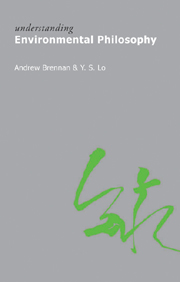Book contents
- Frontmatter
- Contents
- Acknowledgements
- 1 Introduction: the place of environmental philosophy and its basic concepts
- 2 Future generations: what consideration do we owe them?
- 3 Animals: are they as morally valuable as human beings?
- 4 Living things: ethics for the non-human world
- 5 Community: how big is our moral world?
- 6 Natural things: the puzzle of what “natural” means, and whether humans belong to nature
- 7 Foundations: can there be a secular basis for the ideas of human dignity and intrinsic value in nature?
- 8 Origins: political, religious and cultural diagnoses of environmental problems
- 9 Beyond individual responsibility: governance and the affluenzic society
- Questions for discussion and revision
- Further reading
- Bibliography
- Index
1 - Introduction: the place of environmental philosophy and its basic concepts
- Frontmatter
- Contents
- Acknowledgements
- 1 Introduction: the place of environmental philosophy and its basic concepts
- 2 Future generations: what consideration do we owe them?
- 3 Animals: are they as morally valuable as human beings?
- 4 Living things: ethics for the non-human world
- 5 Community: how big is our moral world?
- 6 Natural things: the puzzle of what “natural” means, and whether humans belong to nature
- 7 Foundations: can there be a secular basis for the ideas of human dignity and intrinsic value in nature?
- 8 Origins: political, religious and cultural diagnoses of environmental problems
- 9 Beyond individual responsibility: governance and the affluenzic society
- Questions for discussion and revision
- Further reading
- Bibliography
- Index
Summary
Overview
Most people now under twenty-five have a high probability of being around in fifty years' time. What will the world be like then? At current consumption rates, oil is due to run out in just over forty years, and people then will be living in societies that derive much of the energy for transport from other sources. No one has worked out a viable alternative aviation fuel, so there may be less international air travel, and it may cost much more than at present. Since increasing atmospheric carbon dioxide levels profoundly influence climate change, there will be a drive to reduce reliance on coal as a source of energy, even though there is enough coal on earth to last for another four centuries or so (at present rates of use). Within half a century, the switch to cleaner forms of energy, and the resulting reduction in air pollution, could be one of the major differences from the present. In most of the world's major cities there should be many days where breathing is comfortable and visibility is sparklingly clear, in stark contrast to the situation at present.
Even if the air gets cleaner over the next half century, this will not make much difference to climate changes that – having already started – cannot be stopped. For some time, climate modellers have been warning of the problem of tipping points. These are thresholds for the world's climate, ocean and ecological systems, at which they experience massive discontinuities.
- Type
- Chapter
- Information
- Understanding Environmental Philosophy , pp. 1 - 17Publisher: Acumen PublishingPrint publication year: 2010



